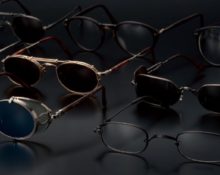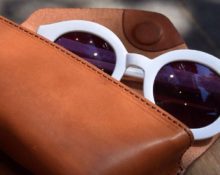Modern sunglasses are more often perceived as an accessory that allows you to complement your outfit. Well, our ancestors attributed completely different functions to them. Some sought protection from what they saw in tinted and colored lenses, others hoped to use them to prolong youth. Find these and other interesting facts about glasses in this article.
Who invented sunglasses?
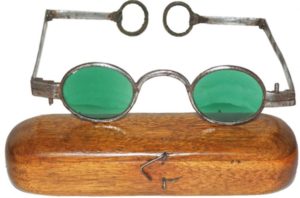 It is reliably known that the pharaohs used an analogue of sunglasses. Confirmation of this was found in the tombs of the rulers of Ancient Egypt. The colored lens was first invented by James Askew.. This happened in 1752. By the way, the new product did not interest the public. In his entire life and career as an optician, Askew only sold 2 pairs. Well, functional and safe sunglasses appeared only in the 20th century. Their “birth” is associated with 2 companies:
It is reliably known that the pharaohs used an analogue of sunglasses. Confirmation of this was found in the tombs of the rulers of Ancient Egypt. The colored lens was first invented by James Askew.. This happened in 1752. By the way, the new product did not interest the public. In his entire life and career as an optician, Askew only sold 2 pairs. Well, functional and safe sunglasses appeared only in the 20th century. Their “birth” is associated with 2 companies:
- Bausch + Lomb;
- Polaroid.
The first manufacturer is a pioneer in anti-glare glasses.The second one came up with polarizing lenses that filter horizontal light waves and rays reflected from surfaces.
History of appearance
In the tomb of Tutankhamun, archaeologists found a device that vaguely resembles modern glasses. Instead of glass, this design featured the finest cut of emerald. The “lenses” were connected using a bronze plate - apparently, it served as a “bridge” of the frame and nose pad. The arms were missing.
Important! Emerald was not chosen by chance. In many pre-Christian religions, mystical properties were attributed to this stone. Its most “modest” function, according to the ancient Helladians, is softening the event seen. This property was especially appreciated by spectators who regularly attended mortal battles in the arena. It is known for sure that Nero, a lover of bloody fights without rules, used a kind of lorgnette with an emerald.
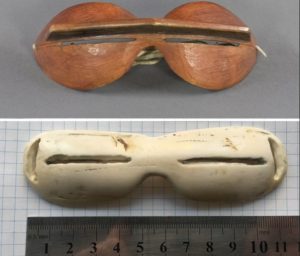 The predecessors of modern glasses were in demand among residents of all more or less developed countries located in warm climates. Ancient China, Japan, India - in every state, high-ranking people sought to protect their eyes from the sweltering sun.
The predecessors of modern glasses were in demand among residents of all more or less developed countries located in warm climates. Ancient China, Japan, India - in every state, high-ranking people sought to protect their eyes from the sweltering sun.
Paradoxically, the indigenous inhabitants of the Far North also dreamed of the same thing. They were blinded by the rays reflected from the snowy surface. True, unlike the Greeks and Egyptians, they solved optical problems not at the expense of a precious stone, but with face bandages. Such an accessory did not dim the light or filter the rays, but only reduced the size of the perceived light waves due to the narrowness of the lens slits.
The further development of sun-protection optical devices is associated with the name James Askew. He managed to get a blue lens. However, his contemporaries did not take advantage of his achievements. AND It was only during the era of Napoleon’s campaigns that the idea of a device allowing one to see in clear weather was brought to life. Bonaparte, who later failed to protect his army from frost, managed to “conquer” the sun and win African wars with the help of the forerunner of modern sunglasses. True, the design used by the soldiers of the great commander looked very strange. The glass was smoked and additionally varnished on top.. Through such a barrier, not only the glare of the sun, but also the surrounding objects were not visible.
Throughout the 19th century, opticians persistently improved Askew's work. As a result, aristocrats and European government officials became interested in their successes. The first began to buy unusual glasses for themselves, the second put the production of optical devices on stream and supplied their armies with them.
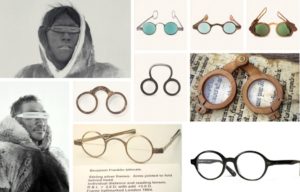 The events described took place at the end of the 19th and beginning of the 20th centuries, during an era of change. It was then that various types of transport appeared and were actively improved, including cars and airplanes. The first drivers and pilots were required to wear sunglasses (they needed to protect their eyes from the flow of wind and small debris, the issue with the sun faded into the background). In other words, technological progress was the one who transferred glasses from the category of “a thing to soften what you saw” into the category of “a vital device, a mandatory element of equipment.”
The events described took place at the end of the 19th and beginning of the 20th centuries, during an era of change. It was then that various types of transport appeared and were actively improved, including cars and airplanes. The first drivers and pilots were required to wear sunglasses (they needed to protect their eyes from the flow of wind and small debris, the issue with the sun faded into the background). In other words, technological progress was the one who transferred glasses from the category of “a thing to soften what you saw” into the category of “a vital device, a mandatory element of equipment.”
In beach conditions, the accessory began to be used a little later. In 29, Sam Foster Grant came up with the idea to offer a new product to swimmers and sunbathers. He did this without leaving the cash register, that is, on the coast itself.
well and the fashionable accent of glasses appeared during the reign and fall of Hitler. At that time, the weaving industry was in decline and was geared towards the production of military uniforms, so designers, without further ado, enthroned the military style. Glasses, a “vital device” for pilots, sailors, and military drivers, also became part of this trend. Since then, the accessory has become something more than just an attribute for a beach holiday or a device for protecting the eyes.
How have glasses changed from antiquity to modern times?
The first real glasses were quite massive and heavy. Modern versions often weigh almost nothing, since, with some exceptions, they do not contain glass, but lenses made of super-light material.
Functionality and myths associated with it
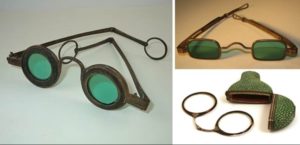 The first glasses of the northerners worked by reducing the clearance. Little light entered the eye, due to this the person is not blind from the abundance of whiteness and rays reflected from the snow. Well, the Greeks and residents of some other countries attributed more mystical properties to glasses than practical ones. Thus, residents of Ancient Japan believed that devices for protecting their eyes from the sun helped them not to age.
The first glasses of the northerners worked by reducing the clearance. Little light entered the eye, due to this the person is not blind from the abundance of whiteness and rays reflected from the snow. Well, the Greeks and residents of some other countries attributed more mystical properties to glasses than practical ones. Thus, residents of Ancient Japan believed that devices for protecting their eyes from the sun helped them not to age.
European opticians of the 18th and 19th centuries also insisted on the medical qualities of colored sunglasses, but their assumptions regarding the corrective capabilities of yellow glasses were not confirmed. Modern accessories can be very useful (such products protect against the aggressive effects of UV rays, small debris and danger arising from poor visibility during bad weather or bright sunshine), and harmful (such accessories strain the eyes and interfere with the perception of the picture). The only difference between the first and second options is the ability to choose the right glasses.
Important! Although yellow ones are not suitable for vision correction; this requires lenses with diopters, they still have a useful quality. They enhance the contrast of the image.
Design
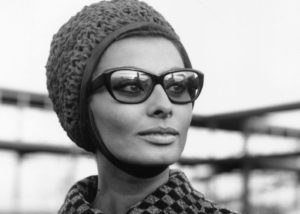 All modern popular frames were invented in the 20th century.. Before this, lenses were inserted into wooden, fabric, steel structures and bandages. In those days, they didn’t think much about the beauty of such an object; the main task was to hold the painted glass. Well, the first fashionable options - common at the beginning of the 20th century - were made from turtle shells. These were already really skillfully made devices, but heavy and very expensive.
All modern popular frames were invented in the 20th century.. Before this, lenses were inserted into wooden, fabric, steel structures and bandages. In those days, they didn’t think much about the beauty of such an object; the main task was to hold the painted glass. Well, the first fashionable options - common at the beginning of the 20th century - were made from turtle shells. These were already really skillfully made devices, but heavy and very expensive.
Lenses are constantly being improved to this day.. Moreover, the paradox lies in the fact that the black glass we are familiar with and the most common was created later than some colored glasses. For example, green and blue.
Interesting facts about the emergence of popular frames of our time
 Aviators. In the 30s–40s. In the 20th century, a number of American companies specializing in the production of frames and lenses worked under government orders. According to it, they supplied pilots and sailors with a special type of glasses. This model was called AN6532. With the reign of military style on fashion catwalks, the peak of popularity came in the 40s and 50s. 20 V – AN6532 glasses are no longer the prerogative of the military. They began to be worn by civilians, who replaced the alphanumeric abbreviation with the convenient name “aviators.”
Aviators. In the 30s–40s. In the 20th century, a number of American companies specializing in the production of frames and lenses worked under government orders. According to it, they supplied pilots and sailors with a special type of glasses. This model was called AN6532. With the reign of military style on fashion catwalks, the peak of popularity came in the 40s and 50s. 20 V – AN6532 glasses are no longer the prerogative of the military. They began to be worn by civilians, who replaced the alphanumeric abbreviation with the convenient name “aviators.”- Weifers. The first non-metallic glasses. Plastic frames appeared 20 years after the invention of aviators.
- Panto. 3 countries claim to be the “creators” of this model. Where pantos were actually invented - in France, England or America - is unknown. It is also noteworthy that such glasses were supplied to soldiers and officers in World War II.They were also worn by the highest ranks of Nazi Germany.
- Chanterelles. Modern girls and fashion industry connoisseurs associate the model with iconic Hollywood actresses of the early-mid last century, but domestic rockers who lived through the 80s and 90s know that foxes are Tsoi’s glasses. And huge queues lined up for “Tsoi glasses”. It was the ultimate dream.
- Browliners. In fact, this is a modified version of the aviators. She was at the peak of her popularity in the 50s.
- Tisheydy. Many people have a strong association between perfectly round glasses and Harry Potter. In fact, we have John Lennon to thank for the widespread use of this frame. It was his love for tishades that became the basis for their popularity.
Interesting! We owe a debt of gratitude to John Lennon not only for popularizing the tee-shades, but also for creating radically darkened lenses. True, he only took an indirect part in the process, but without him Yoko Ono, his widow, would never have thought of impenetrable glass. More precisely, she would not have had a reason (the death of her husband).


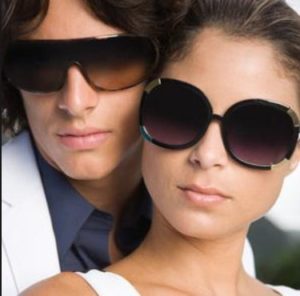
 0
0



